
Go is an abstract strategy board game for two players in which the aim is to fence off more territory than the opponent. The game was invented in China more than 2,500 years ago and is believed to be the oldest board game continuously played to the present day. A 2016 survey by the International Go Federation's 75 member nations found that there are over 46 million people worldwide who know how to play Go, and over 20 million current players, the majority of whom live in East Asia.

Baozhong tea, sometimes romanized as pouchong, is a lightly oxidized tea, twist shape, with floral notes, and usually not roasted, somewhere between green tea and what is usually considered oolong tea, though often classified with the latter due to its lack of the sharper green tea flavours. It is produced mainly in Fujian, China and in Pinglin District, New Taipei, Taiwan.
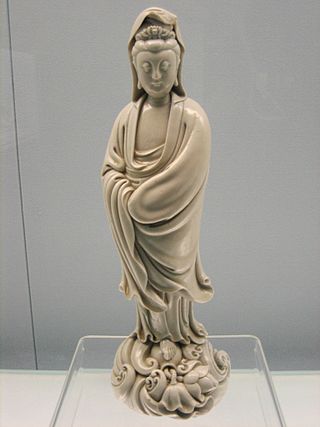
A figurine or statuette is a small, three-dimensional sculpture that represents a human, deity or animal, or, in practice, a pair or small group of them. Figurines have been made in many media, with clay, metal, wood, glass, and today plastic or resin the most significant. Ceramic figurines not made of porcelain are called terracottas in historical contexts.

A rock garden, also known as a rockery and formerly as a rockwork, is a garden, or more often a part of a garden, with a landscaping framework of rocks, stones, and gravel, with planting appropriate to this setting. Usually these are small Alpine plants that need relatively little soil or water. Western rock gardens are often divided into alpine gardens, scree gardens on looser, smaller stones, and other rock gardens.

Cui Jian or Choi Geon is a Beijing-based Chinese singer-songwriter, trumpeter and guitarist. Affectionately called "Old Cui", he is credited with pioneering Chinese rock music. For this distinction he is often labeled the "Father of Chinese Rock". He is also known in the Chinese rock music industry as a "leader in promoting the true singing movement" and the "first person in Chinese rock".

A gravestone or tombstone is a marker, usually stone, that is placed over a grave. A marker set at the head of the grave may be called a headstone. An especially old or elaborate stone slab may be called a funeral stele, stela, or slab. The use of such markers is traditional for Chinese, Jewish, Christian, and Islamic burials, as well as other traditions. In East Asia, the tomb's spirit tablet is the focus for ancestral veneration and may be removable for greater protection between rituals. Ancient grave markers typically incorporated funerary art, especially details in stone relief. With greater literacy, more markers began to include inscriptions of the deceased's name, date of birth, and date of death, often along with a personal message or prayer. The presence of a frame for photographs of the deceased is also increasingly common.

A stele, from Greek στήλη, stēlē, plural στήλαι stēlai, is a stone or wooden slab, generally taller than it is wide, erected in the ancient world as a monument. The surface of the stele often has text, ornamentation, or both. These may be inscribed, carved in relief, or painted.
A Go game record is an archival record for a game of Go.
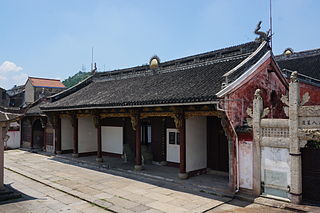
Shangyu District is a district of the prefecture-level city of Shaoxing in the northeast of Zhejiang province, China. At the 2010 census, its population in the built-up area was 779,412, up from 722,523 in the 2000 census. Shangyu is roughly fifty kilometers from north to south and about thirty kilometers from east to west. It makes up about one-fourth of the area of Shaoxing prefecture. Shangyu District is not part of the Hangzhou-Shaoxing built-up area as some countryside still prevent the city from being conurbated until now.

Zhangjiajie, is a prefecture-level city in the northwestern part of Hunan Province, China. It comprises the district of Yongding, Wulingyuan and counties of Cili and Sangzhi. It contains the Zhangjiajie National Forest Park, part of the Wulingyuan Scenic Area which was designated as a UNESCO World Heritage Site in 1992.

A Go opening is the initial stage of a game of Go. On the traditional 19×19 board the opening phase of the game usually lasts between 15 and 40 plies. There is some specialised terminology for go openings. The precise meanings of Japanese language terms is often misunderstood.
"So What" is the first track on the 1959 album Kind of Blue by American trumpeter Miles Davis.

Manjū is a traditional Japanese confection, usually a small, dense bun with a sweet filling. They come in many shapes and varieties.
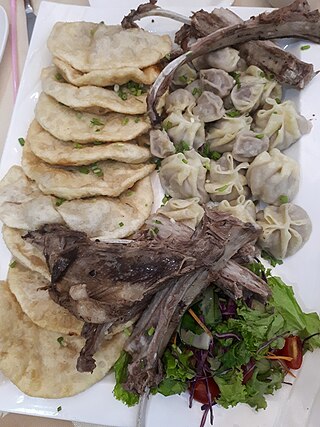
Mongolian cuisine predominantly consists of dairy products, meat, and animal fats. The most common rural dish is cooked mutton. In the city, steamed dumplings filled with meat—"buuz"— are popular.
The biographical novel is a genre of novel which provides a fictional account of a contemporary or historical person's life. Like other forms of biographical fiction, details are often trimmed or reimagined to meet the artistic needs of the fictional genre, the novel. These reimagined biographies are sometimes called semi-biographical novels, to distinguish the relative historicity of the work from other biographical novels
Songzi is a city in the southwest of Hubei province, People's Republic of China, located in the middle reach and southern bank of the Yangtze River. It is a county-level city under the administration of the prefecture-level city of Jingzhou, and controls 16 townships and 2 development zones, 235,000 households and a population of 765,911. It is a long-historied but young and robust city.
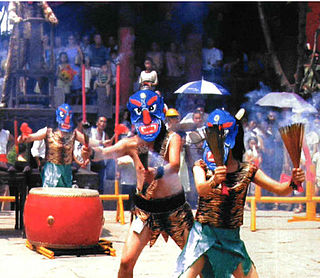
Nuo theatre, Nuo drama, Nuo opera, or Nuoxi is a traditional theatrical art popular in many regions of China. Characterized by its special features such as ferocious masks, unique dresses and adornments, the strange language used in performance, and mysterious scenes, Nuo theatre has been selected as one of the non-material cultural legacies of China. The opera is a religious performance intrinsic to the culture of Nuoism, a type of Chinese folk religion. The purpose of Nuo theatre is to drive away devils, disease and evil influences, and also to petition for blessings from the gods. Singing and dancing are included in Nuo theatre and performers wear costumes and masks.

Kaiyuan Temple is a Buddhist temple located in West Street, Quanzhou, China, and is considered as the largest Buddhist temple in Fujian province with an area of 78,000 square metres (840,000 sq ft). The central figures of veneration in the temple are the Five Tathāgathas from Chinese Esoteric Buddhism who are enshrined in the temple's Mahavira Hall. In 2021, the temple was inscribed on the UNESCO World Heritage List along with other sites near Quanzhou because of its importance during the medieval global maritime trade based in Quanzhou and its testimony to the global exchange of ideas and cultures. The temple is also one of few in China to contain Hindu monuments, left there by traders from Southern India. It is of Buddhist Dense-Eaves architecture and is most famous for the largest stone pagodas in the world, the twin pagodas of Zhenguo and Renshou, which were completed using stone during the Song dynasty.

Chimei wangliang, or Chimimōryō is a term that refers to monsters of the mountains and monsters of the rivers. The term originated in China roughly 2,500 years ago in ancient chronicles such as the Zuo Zhuan. It originates from ancient Chinese legends about the spirits that harm people in the mountains and swamps, and its original meaning is "all kinds of Yaoguai ".
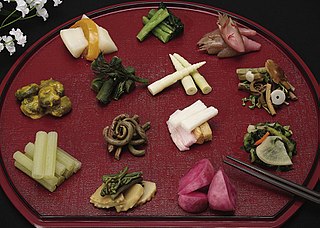
Tsukemono are Japanese preserved vegetables. They are served with rice as an okazu, with drinks as an otsumami (snack), as an accompaniment to or garnish for meals, and as a course in the kaiseki portion of a Japanese tea ceremony.

















